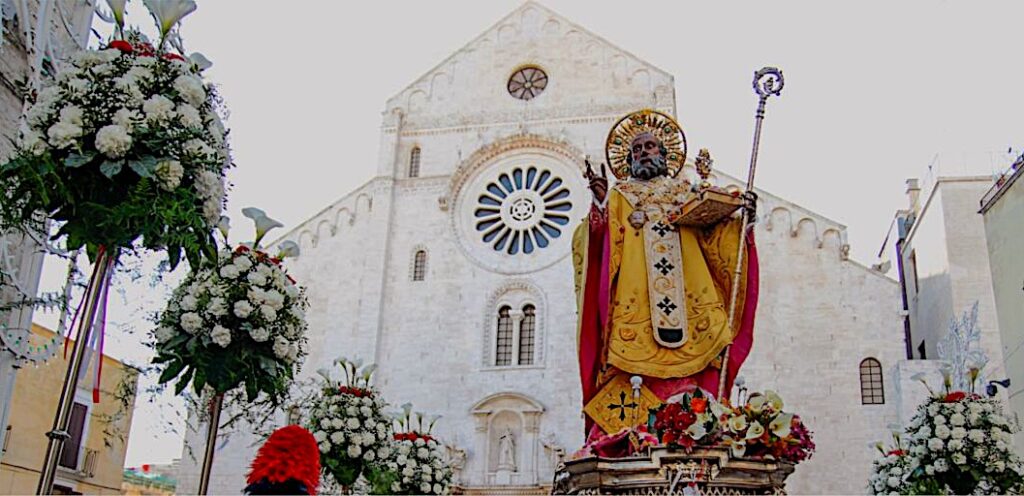Despite the worldwide fame of Father Christmas, there are places where other traditions and legends live on. And Father Christmas himself is none other than Saint Nicholas, born in Turkey in 270 and bishop of Mithras.
Christmas is the religious holiday when all Christians celebrate the birth of Jesus, the son of God, on 25 December. For many decades, the whole festive period has been experienced by families as a time of widespread happiness, characterised by a special festive atmosphere with the magic of decorations and lights.
Religious celebrations have been joined by secular customs and, in many cases, even rampant consumerism, which have little to do with the original spirit of the holiday.
It must be said, however, that even the Christian Christmas has been intertwined for centuries with traditions and legends from the polytheistic Greco-Roman past and with local cultures, giving rise to today’s customs. Such as expecting the classic gifts for all “good children”. But from whom do these gifts come? Every place has its answer.
Thus, if in Portugal it is “Pai Natal” (Father Christmas) who will leave the presents under the tree or, more traditionally, inside the stocking or the shoe hanging from the chimney, in Spain it is the “Reyes Magos” (Three Kings) who deliver the presents on Three Kings’ Day.
Gradually, however, things are changing and even in Spain Father Christmas is beginning to assert himself, with the result that children often receive presents on both 25 December and 6 January, a bit like the Befana in Italy.
Santa Lucia, from Sicily to Veneto
Although Father Christmas is the master, in many parts of Italy it is Santa Lucia who brings gifts to children on 13 December.
It occurs mainly in Lombardy, Trentino, Veneto and Sicily, but also in Scandinavia.
Lucia was born in Syracuse (Sicily) around 282 into a noble family. She was murdered for refusing to marry a young pagan who denounced her to the authorities of the Roman Empire as a Christian (a proscribed religion at the time). She is venerated for her devotion and obedience to God.
In Verona, for example, legend has it that in around 1200 an epidemic spread that affected children and left them blind. Mothers then took their children on a pilgrimage to ask for clemency from Saint Lucy, the patron saint of the blind, and to convince the little ones to brave the cold and fatigue, they promised them that on their return the saint would give them gifts of thanks. Since then, on the night of 12-13 December, the children have been waiting for Saint Lucia to bring the gifts on the back of her donkey.
The most likely origin of this tradition is probably even older, given the coincidence of the night of Santa Lucia with the longest night of the year. In fact, before the introduction of the Gregorian calendar, the winter solstice fell precisely on these feast days for the return of the light and the awakening of the natural cycle, and often, in the countryside, those who had had more abundant harvests donated a portion to those who had had a less fortunate season.
Saint Nicholas, the “real” Father Christmas
To discover the origins of the Father Christmas legend, we move to Apulia, to Bari. In fact, it is Saint Nicholas, patron saint of the city of Bari, who inspired the figure of the most famous gift-giver.
He is one of the world’s most beloved and venerated saints, uniting Catholics and Orthodox, and whose relics, preserved in Bari, are still in dispute with Turkey, which is demanding their return after they were stolen from Myra in 1087 by sailors from Bari. The saint lived in Asia Minor in the 4th century and became bishop of Myra, devoting his whole life to helping people in need, especially children.
Legend has it that Nicholas saved three girls from prostitution by throwing three sacks of gold through an open window as a dowry for a future marriage. Hence the tradition that sees St. Nicholas as the bearer of gifts.
The special relationship with the children is explained by another story according to which the bishop brought back to life three children who had been butchered by a wicked and greedy butcher and dipped in salt to sell their flesh. In fact, the saint is said to have brought the three little ones out of the brine safe and sound.
Between the 7th and 8th centuries, when Byzantines and Arabs fought for supremacy on the sea off the coast where the shrine stood, Nicholas became the Byzantine sailors’ point of reference and protector, and his cult spread along the Mediterranean Sea routes, reaching Rome, Jerusalem, Constantinople, and Russia, and also extending to Germany and the countries of northern Europe.
This is how the Holy Bishop of Myra, over the centuries, became the German Nikolaus or Samiklaus, and the Father Christmas of the Anglo-Saxon countries, who today brings gifts to children at Christmas.
In some regions, however, the gifts still arrive on St. Nicholas’ Day, 6 December. This is particularly the case in north-eastern France, the Netherlands, Germany, and Austria, where tradition has it that the Saint rides along with what is known in France as Père Fouettard, a kind of devil with a whip who punishes naughty children, while the good children will find their presents in the morning in the empty shoes left under the window or by the fireplace.
And St. Nicholas, or San Nicolò, is also a protagonist in South Tyrol, where he defeats the hordes of Krampus, evil creatures who threaten children who have not been good with their sticks, carrying them in the “Kraxn”, a large basket on their shoulders.
The Krampus is a demon mentioned in various German, Austrian and Northern Italian legends who, defeated by Saint Nicholas, becomes his servant, transforming himself, according to some authors, into the well-known elves at the service of Father Christmas.
In South Tyrol, but also in Friuli and Trentino, krampus festivals and parades are held between 5 and 8 December, attracting tourists and onlookers. One of the most famous is the one in Dobbiaco, which can attract up to a thousand participants: South Tyroleans, Swiss, Austrians and Germans gather, parade through the village and the central square in a real spectacle, wearing their masks and costumes.
The cultural heritage of the ancient Romans
To close the circle, and the distribution of gifts, comes the Befana. A tradition particularly felt in the central regions, including Lazio and Tuscany, the Befana also has its roots in pre-Christian festivals and traditions linked to the winter solstice, inherited, and then spread during the Roman Empire.
The origin of the little old lady flying on a broom may derive from the belief that twelve nights after the Sol Invictus (celebrated between the winter solstice and 25 December) Diana, the goddess of lunar cycles and harvests, flew over the fields with her nymphs to bring in future harvests. The giving of gifts or coal to children could instead be linked to the Roman divinity Strenia, symbol of the New Year, celebrated with the traditional exchange of auspicious gifts during the Saturnalia celebrated in the same period (17-23 December).
In fact, Epiphany is a particularly heartfelt feast in Rome. After the Unification of Italy, the celebrations moved from St. Eustace’s Square to Piazza Navona, the historic home of a famous local market, where thousands of citizens and tourists still gather every year, eager to savour the joyful atmosphere of the Roman Epiphany among stalls filled with gifts, games and Christmas sweets.
Finally, in Tuscany, the descent of the Befana from bell towers or palaces is famous. The best known is probably the descent from the Piazza del Campo in Siena, but similar performances take place in Pisa, Pistoia, Livorno and inside the grotto of Equi Terme.



